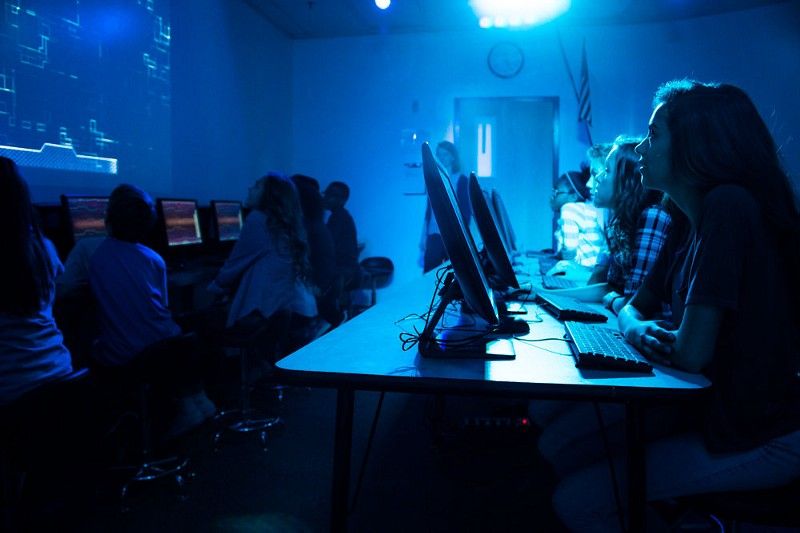“For Title 1 kids and at-risk kids, this program is life-changing. These kids come from homes where most things are broken. In class, they typically learn they aren’t good at school. Then we put them in a situation that’s abstract, where they have to communicate and speak out of turn, where they have to take risks, and they’re just good at it. It’s such a transformative process for these kids to come out saying, ‘I was good at that.’”
This article appears in the Fall 2017 issue of Silicon Slopes Magazine. For the print version, subscribe to Utah Business Magazine and you will automatically be sent a quarterly copy of Silicon Slopes Magazine.
Remember life as a grade schooler.
You wake early to a breakfast of Honeycomb, load into a yellow school bus with friends at your side. Celebrate early morning freedom on the playground, shooting hoops through silver chains of metal. The bell rings and your heart sinks. Today you learn about the water cycle, science of condensation, what causes liquid to pour from the sky — not subjects that interest a young mind. You spend hours chewing a pink eraser, doodles etched on the side of your worksheet, praying for lunchtime or recess. Anything but this. There is nothing to stimulate your brain, nothing to interest the part of you that craves cerebral engagement.
Now envision life as a grade schooler in 2017 and what it could be.
Your teacher stands in front of the classroom and delivers an ultimatum: “If you don’t understand the water cycle, your mission will fail.” You study the intricacies of clear blue water, how it fuels everything in life. Exchange ideas with classmates, share your nervous excitement about the upcoming mission. When it’s time, you travel to a computer lab transformed. Lights flash everywhere, yellow and green, alarms sounding over the loudspeakers. For 60 minutes, you work together as a team — speak with foreign aliens, fly through endless space, attempt to recreate the water cycle on distant planets. The mission is a success and when it’s over, you shout and scream, ecstasy rising like a flood. You slap hands with those around you, congratulate each other on a job well done. This is a feeling you will remember.
Skyler Carr is the co-founder of InfiniD Learning. He recalls a time in his youth when he traveled to the Christa McAuliffe Space Education Center in Pleasant Grove, a Star Trek-type space simulator that served as a popular destination for grade school field trips. When Carr participated, he fell in love.
“It was one of those things in elementary school that was super impactful for me — one of the the first times I did something where I had to solve problems, make mistakes, work with a team, all of these new skills I’d never used before,” said Carr. “It was an amazing experience.”
Inspired by his childhood experience, Carr eventually volunteered to help out with the program, reborn as a laser gun-wielding alien. It was during this time that he began to gain a greater understanding of the interaction between students and learning — engagement is a must.
“These schools coming in were always looking for ways to do it again, because it was so impactful for their kids,” said Carr. “I started doing research, working with teachers and schools, trying to figure out how to get this immersive simulation program into schools. We tested some different ideas and ultimately arrived at a simple software package, a few lights that clip into the ceiling, and audio integration that turns their computer lab into a Magic School Bus.”
![]()
InfiniD Learning ran its pilot program with Lakeview Academy in Saratoga Spring and the results were excellent — kids loved the engagement offered by learning missions and teachers loved that they could get children to learn subjects they might not be interested in without real stakes attached.
Through InfiniD, a happy medium was reached. Students would learn a subject over the course of multiple weeks, with a 60-minute mission attached as the end destination. Each child would be assigned a job (captain, engineer, first mate, etc.) and expected to contribute as part of a larger team, using their combined knowledge to fly a spaceship, navigate a submarine, or control an ecosphere inside someone’s bloodstream. Teachers would teach their curriculum like always, with the expectation that students would need to learn or risk mission failure.
Carr sat in and watched many of these missions, noticing a common theme — kids went bonkers. Through the light and audio integration, any school’s computer lab could be changed to the vehicle of their choice. The teacher would be connected via microphone, using a voice modulator to interact with students, disguised as an alien or another foreign entity. Kids could have real conversations with anyone they encounter, then use their problem solving skills to complete the mission.
“We look at it as a month-long cycle, even though the mission is 60 minutes,” said Carr. “The mission is the capstone for whatever standard they learned. So for fourth graders, water cycle is a standard they have to learn — it’s really hard to get kids excited about the water cycle. When it comes mission time, you push a button and our lights turn on, blue, red, green, whatever we need them to be. If the students turn left and crash into an asteroid, the lights will flash, they hear explosions, they scream because they think it’s real. For the water cycle experience, their teacher will say, ‘We’re going to learn about the water cycle, you need to know this because in three weeks you’re going on a mission to help a planet where the water cycle has collapsed. There are people en route to live there and if there is no water cycle, they won’t survive. You have a very short amount of time to figure out what’s broken.’ That’s the lock-in point where kids now care.”
InfiniD worked with three more schools last year, sharpening the concept of replacing traditional schoolwork with applied learning. Carr says they will be working with 30 Utah-based schools in the 2017–2018 school year, concentrating on every science standard from kindergarten to ninth grade. Knowing of the price restraints that can shackle many schools, Carr stresses affordability.
“Science is where a lot of the funding is and we want to have something that schools can actually buy and afford,” Carr said. “Science is also where a lot of the struggle is, where kids just don’t care anymore. Every single science standard for K-9, we’re passionate about young kids getting excited early.”
![]()
With over 60 unique missions, InfiniD wants to cover all bases. Whatever the learning standard calls for, they design different simulations — space exploration, time travel, volcano examination, even floating through a human body. By working alongside teachers, the hope is to provide the best-case scenario for applied learning.
“From the very beginning, we’ve been obsessed with teachers — what they need and what they want,” said Carr. “We’ve gotten so much good content by letting teachers develop it. Every school we sign up, if they have an idea for a mission, we’ll work with them — build the graphics, code it in, have it ready within a month. That’s how our very best missions are created, working with teachers who are picturing their kids and their content.”
Learning, tailored and applied — that’s the mission of InfiniD Learning. Kids who struggle with some of school’s traditional methods have welcomed InfiniD with open arms, excited to apply their smarts to something beyond a worksheet or textbook. There is value in experience, especially for children who want to know why the water cycle is relevant or comprehend information on tectonic plates. Through InfiniD’s mission, teachers are able to teach their own curriculum with a tangible endpoint in mind: a 60-minute mission with flashing lights, booming sounds, otherworldly adventures, and applied learning. That’s something kids can grasp, embrace, and remember.
“For Title 1 kids and at-risk kids, this program is life-changing,” said Carr. “These kids come from homes where most things are broken. In class, they typically learn they aren’t good at school. Then we put them in a situation that’s abstract, where they have to communicate and speak out of turn, where they have to take risks, and they’re just good at it. It’s such a transformative process for these kids to come out saying, ‘I was good at that.’ We’ve had principals call us in tears, saying they reached kids they never dreamed they would be able to reach. That are stopping them in the halls and telling them all about these experiences they just had, the problems they solved, how they might have failed but they’re excited to try again next week.”




